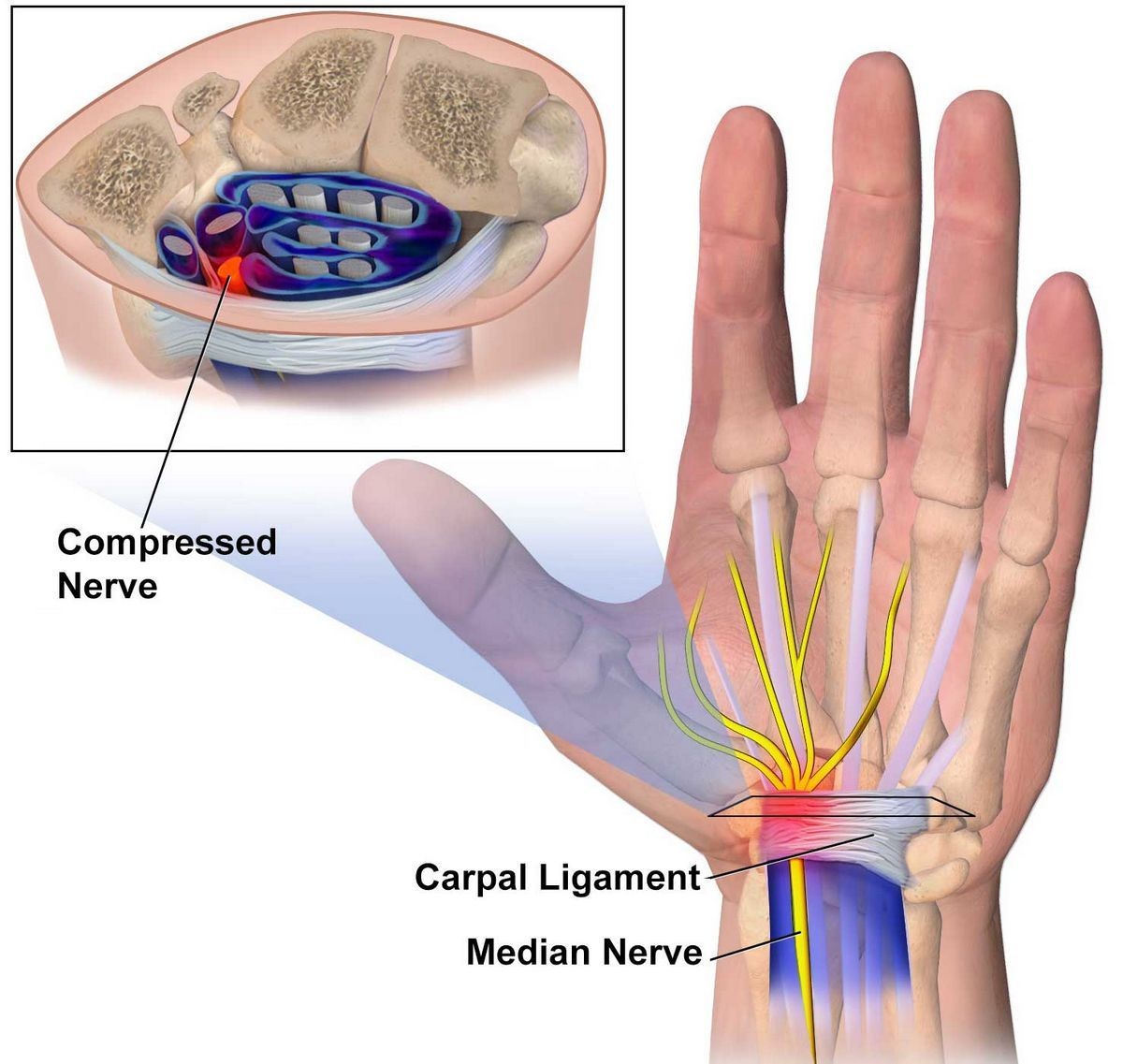
Contents
- 1 Carpal Tunnel Syndrome
- 1.0.1 What are the symptoms of carpal tunnel syndrome?
- 1.0.2 Diagnosis and testing for carpal tunnel syndrome
- 1.0.3 What are the stages of carpal tunnel syndrome?
- 1.0.4 What is the treatment for carpal tunnel syndrome?
- 1.0.5 What are the complications if carpal tunnel syndrome is left untreated?
- 1.0.6 What is the prognosis for carpal tunnel syndrome?
Carpal Tunnel Syndrome
The cause of carpal tunnel syndrome is often unknown. Any condition that puts pressure on the median nerve at the wrist can cause it.
Common conditions that can lead to carpal tunnel syndrome include:
- Obesity
- Pregnancy
- Thyroid disorders (such as hypothyroidism)
- Arthritis (such as rheumatoid arthritis)
- Diabetes
- Trauma or injury
Repetitive work, like uninterrupted typing, can also cause carpal tunnel symptoms. Carpal tunnel syndrome from repetitive hand and wrist movements is considered a repetitive stress injury, although this relationship is controversial.
Hormonal changes during menopause or pregnancy can increase the risk of developing carpal tunnel syndrome.
Some rare diseases can cause abnormal substances in and around the carpal tunnel, leading to nerve irritation. These diseases include:
Beyond that, some people may have a genetic predisposition to carpal tunnel syndrome. This may include certain anatomical features like a smaller carpal tunnel or a protruding wrist bone.
What are the symptoms of carpal tunnel syndrome?
People with carpal tunnel syndrome initially feel numbness and tingling of the hand in the distribution of the median nerve (the thumb, index, middle, and thumb side of the ring fingers). These sensations are often pronounced at night and can wake people from sleep. Symptoms are worse at night due to the flexed wrist sleeping position and fluid accumulation around the wrist and hand.
Carpal tunnel syndrome can be temporary or persistent.
The main symptoms of CTS may include:
- Burning sensation, cramping, and weakness of the hand as the disease progresses
- Decreased grip strength leading to frequent dropping of objects
- Occasional sharp shooting pains in the forearm
- Increased sensitivity to temperature in the affected hand
- Muscle wasting (atrophy) of hand muscles near the base of the thumb in the palm
Diagnosis and testing for carpal tunnel syndrome
Carpal tunnel syndrome is suspected based on symptoms and hand numbness distribution.
- Examination of the neck, shoulder, elbow, pulses, and reflexes can exclude conditions mimicking carpal tunnel syndrome.
- Wrist examination can check for swelling, warmth, tenderness, deformity, and discoloration.
- Tapping the front of the wrist can reproduce hand tingling (Tinel’s sign).
- Symptoms can also be reproduced by bending the wrist downward (Phalen’s maneuver).
A nerve conduction velocity test can confirm the diagnosis. It measures the speed of electrical impulses as they travel down a nerve. In carpal tunnel syndrome, the impulse slows as it crosses the carpal tunnel. An electromyogram may also be performed to exclude or detect other conditions.
Blood tests might be done to identify medical conditions associated with carpal tunnel syndrome.
What are the stages of carpal tunnel syndrome?
Carpus means "wrist" in Greek. The wrist is surrounded by a band of fibrous tissue that supports the joint. The tight space between this band and the wrist bone is the carpal tunnel. The median nerve passes through the carpal tunnel to receive sensations from the thumb, index, and middle fingers.
Any condition that causes swelling or a change in the position of the tissue within the carpal tunnel can squeeze and irritate the median nerve. Irritation of the median nerve in this way causes carpal tunnel syndrome.
The three stages of CTS include:
- Stage 1: Mild symptoms such as occasional numbness, weakness, or tingling that is more prominent at night
- Stage 2: More frequent or persistent symptoms, including tingling, numbness, weakness, pain, and loss of grip strength
- Stage 3: Constant symptoms that impair function, including significant weakness and muscle wasting
Not everyone with CTS experiences all these stages, and symptom severity varies.
QUESTION
What is the treatment for carpal tunnel syndrome?
The choice of treatment depends on symptom severity and underlying diseases.
Initial treatment usually includes:
- Rest
- Wrist immobilization with a splint
- Occasional ice application
Activity modification may be necessary for those with aggravating occupations. Adjusting computer keyboards and chair height can optimize comfort. Resting, periodic range of motion stretching exercises, and avoiding repetitive overuse can prevent symptoms. Underlying conditions are treated individually.
Orthopedic management may be required for fractures. Weight reduction advice is given to obese individuals. Measures directed against underlying arthritis are used for rheumatoid disease. Pregnancy-related wrist swelling resolves after delivery.
Several medications can be used to treat carpal tunnel syndrome.
- Vitamin B6 (pyridoxine): May relieve symptoms, although its mechanism is unknown
- Nonsteroidal anti-inflammatory drugs: Reduce inflammation and pain, but gastrointestinal side effects can occur
- Corticosteroids: Given orally or injected into the wrist joint, they rapidly relieve symptoms. Short courses have minimal side effects, but they can aggravate diabetes and should be avoided with infections.
Most patients with carpal tunnel syndrome improve with conservative measures and medications.
Surgery may be necessary for persistent numbness and weakness. It involves cutting the tissue around the wrist to reduce pressure on the median nerve. Rehabilitation exercises often follow surgery. Although uncommon, symptoms can recur.
What are the complications if carpal tunnel syndrome is left untreated?
Complications of carpal tunnel syndrome include muscle atrophy and weakness at the base of the thumb, leading to a lack of finger dexterity if left untreated.
What is the prognosis for carpal tunnel syndrome?
The outlook is generally excellent as carpal tunnel syndrome usually responds to conservative measures. Surgical treatment is sometimes necessary, and residual weakness can occur.
References:
Koopman, William, et al., eds. Clinical Primer of Rheumatology. Philadelphia, Pa.: Lippincott Williams & Wilkins, 2003.
Ruddy, Shaun, et al., eds. Kelley’s Textbook of Rheumatology, 6th Ed. Philadelphia, Pa.: Saunders, 2001.


